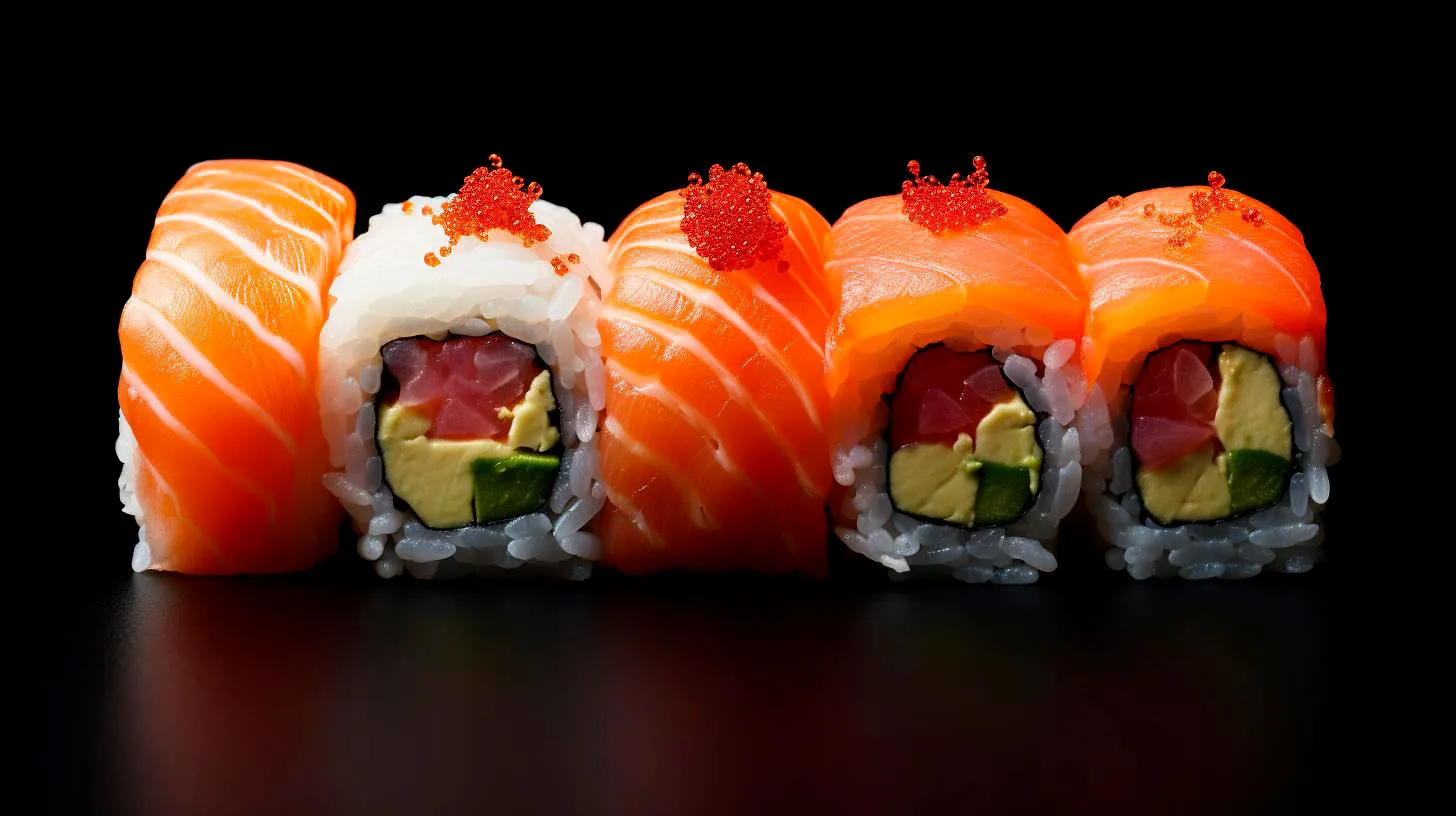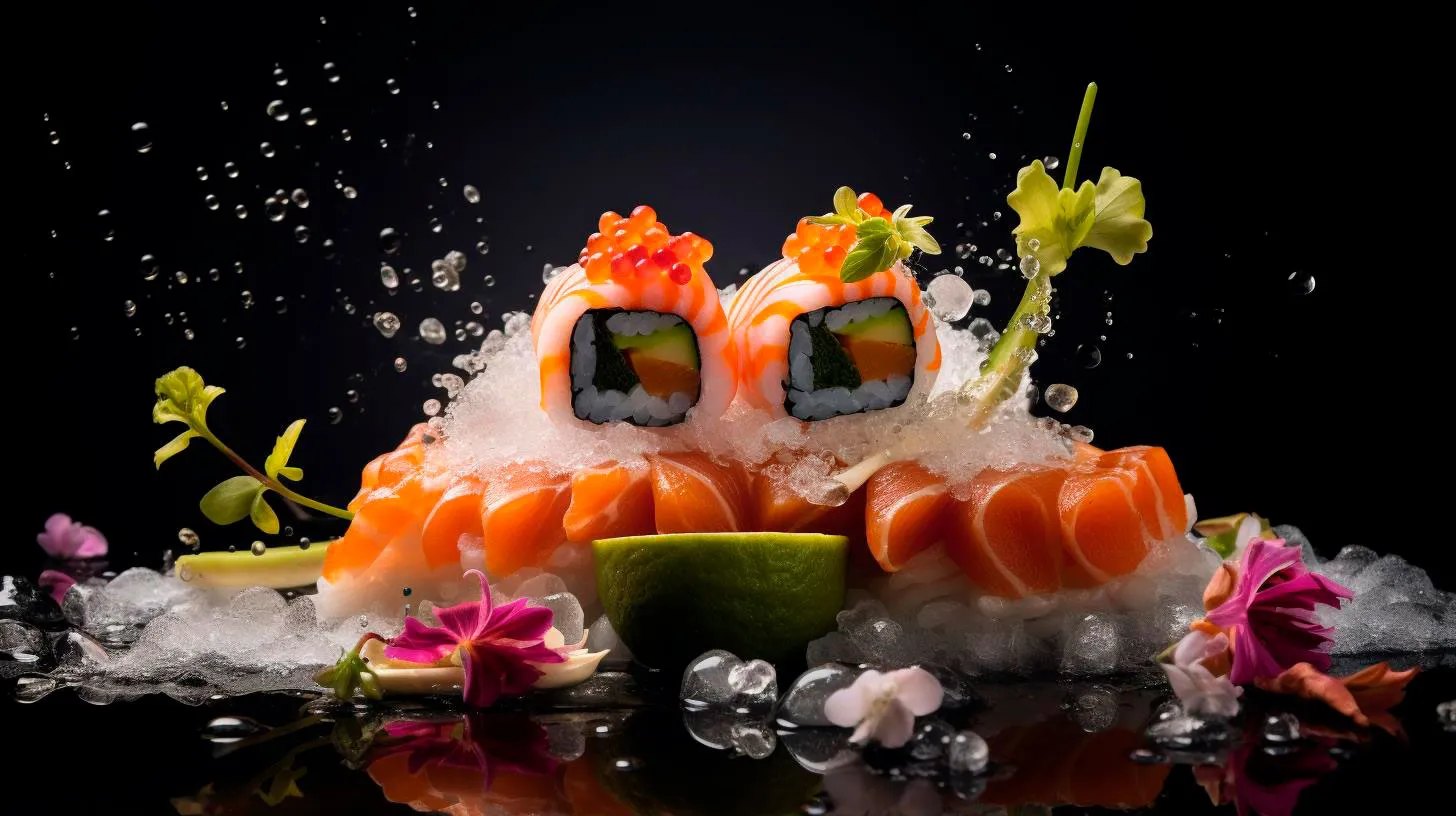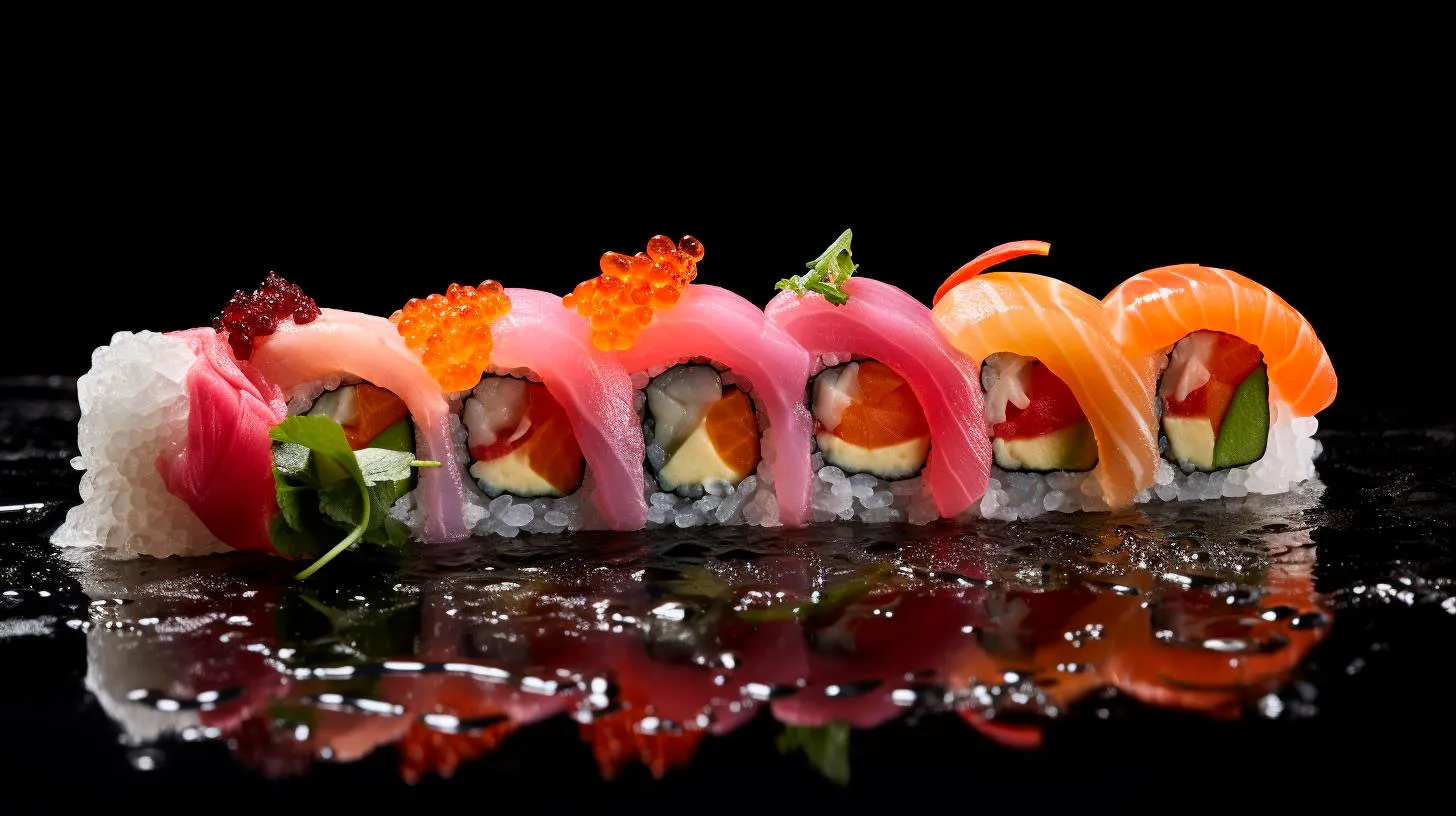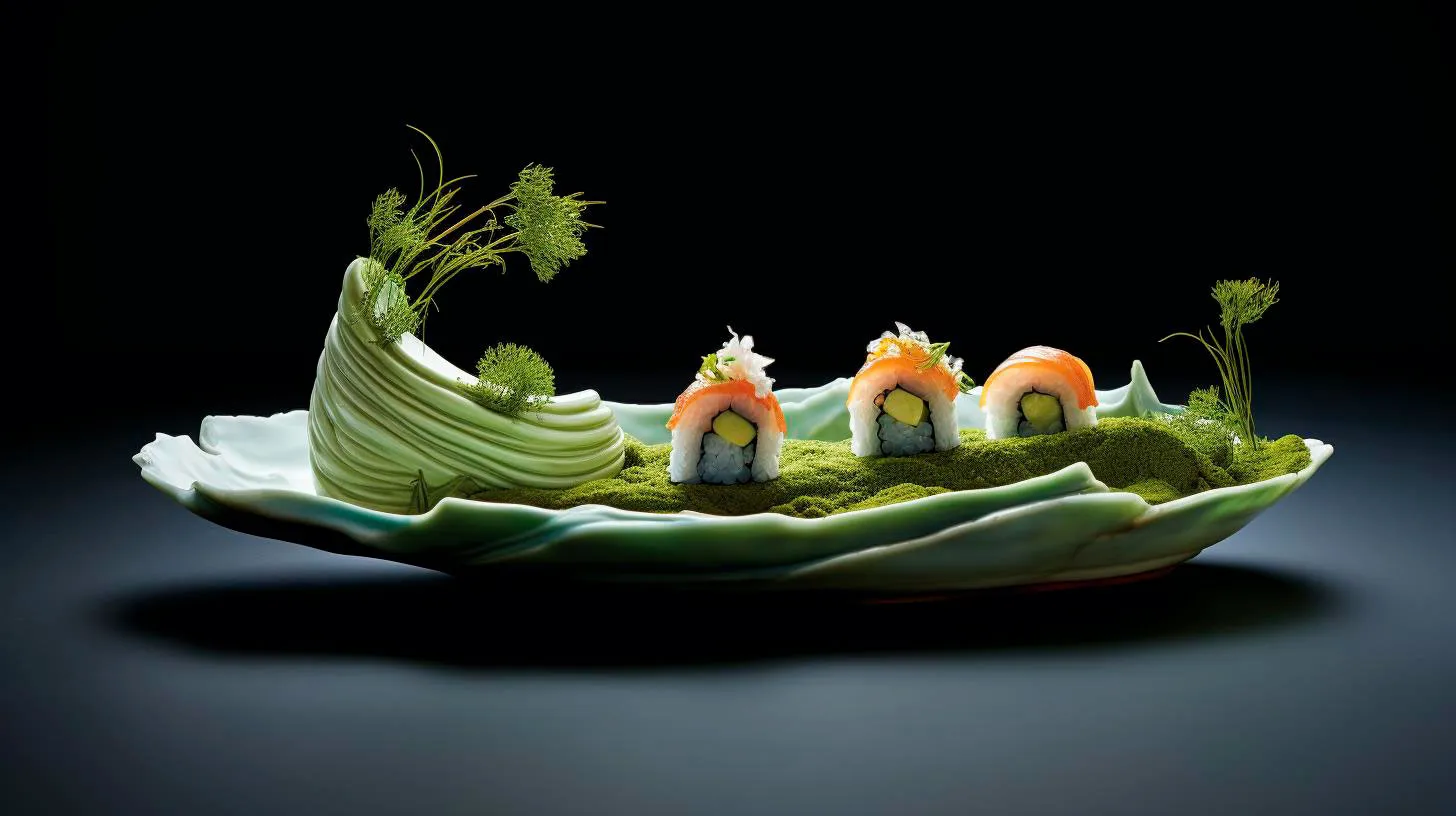Innovative Sushi Rolling Techniques Beyond Traditional Maki Rolls
In this article, we will explore some exciting techniques that go beyond the conventional maki rolls, providing a delightful twist to your sushi experience.
1. Temaki Sushi: Hand Rolls
Temaki sushi, also known as hand rolls, offer a unique and convenient way to enjoy sushi. Rather than rolling the ingredients into a compact cylindrical shape, temaki sushi involves creating a cone-shaped roll. This technique allows you to customize each roll to suit your taste preferences. You can fill it with your favorite ingredients, such as fresh fish, avocado, cucumber, and even tempura. The key advantage of temaki sushi is that it can be easily prepared and enjoyed without any special sushi-rolling skills.
Key takeaway:
- Temaki sushi provides a customizable and convenient way to enjoy sushi.
- It does not require advanced sushi-rolling techniques.
- Offers endless possibilities for fillings and flavors.
2. Uramaki: Inside-Out Rolls
Uramaki, also known as inside-out rolls, is a sushi rolling technique where the rice is on the outside, wrapped around the fillings. This innovative style of sushi offers a visually appealing presentation and allows for more experimentation with ingredients. Common fillings for uramaki rolls include seafood, avocado, cucumber, and even cream cheese. These rolls are often topped with sesame seeds or tobiko (fish roe) to enhance the flavors and add a crunchy texture.
Key takeaway:
- Uramaki rolls are visually appealing and offer a unique presentation.
- They provide more opportunities for experimentation with flavors and ingredients.
- Toppings such as sesame seeds or tobiko enhance the taste and texture.
3. Gunkan Maki: Battleship Rolls
Gunkan maki, also known as battleship rolls, are small and boat-shaped sushi rolls that can hold loose or delicate fillings. The technique involves wrapping a strip of nori seaweed around a ball of rice, leaving the top open. This allows for the placement of ingredients that would otherwise be difficult to include in traditional maki rolls, such as fish roe, sea urchin, scallops, or even marinated mushrooms. Gunkan maki provides a unique blend of textures and flavors that sushi enthusiasts will undoubtedly appreciate.
Key takeaway:
- Gunkan maki rolls offer the perfect vessel for delicate or loose fillings.
- They allow for the inclusion of ingredients like fish roe and sea urchin.
- Provide a delightful blend of textures and flavors.
4. Oshi Sushi: Pressed Sushi
Oshi sushi, or pressed sushi, is a traditional sushi style originating from the Osaka region of Japan. This technique involves pressing layers of sushi rice and ingredients into a rectangular mold called an oshibako. Once compressed, the sushi is then cut into bite-sized pieces. Oshi sushi offers a unique presentation and allows for beautiful layering of various ingredients. This style of sushi is particularly popular for including toppings such as salmon, mackerel, or vegetables. The pressing process enhances the flavors and textures, resulting in a distinct sushi experience.
Key takeaway:
- Oshi sushi provides a visually appealing presentation with layered ingredients.
- Toppings such as salmon and mackerel are commonly used.
- Pressing the sushi enhances the overall flavors and textures.
5. Aburi Sushi: Flame-Seared Sushi
Aburi sushi, or flame-seared sushi, adds an exciting twist to traditional maki rolls. This technique involves lightly searing the surface of the fish or other ingredients using an open flame. The result is a slightly charred, smoky flavor that enhances the overall taste of the sushi. Popular in high-end sushi restaurants, aburi sushi offers a perfect balance of textures and flavors. Additionally, the searing process also helps to remove any potential fishy aftertaste while preserving the freshness of the ingredients.
Key takeaway:
- Aburi sushi provides a unique smoky flavor through flame-searing.
- It offers a perfect balance of textures and flavors.
- The searing process enhances the overall taste, removing any fishy aftertaste.
In conclusion, sushi rolling techniques have evolved far beyond the traditional maki rolls. From the customizable hand rolls of temaki sushi to the visually stunning uramaki rolls and the delightful battleship rolls of gunkan maki, these innovative techniques add excitement and variety to sushi lovers worldwide. Additionally, the pressed sushi of oshi sushi and the distinctive flavors of aburi sushi provide further opportunities to explore the world of sushi.
So why not take your sushi experience to the next level and try these innovative rolling techniques? Whether you’re a sushi enthusiast or a beginner, these techniques offer endless possibilities for delicious and visually appealing creations. Unleash your creativity, experiment with ingredients, and enjoy the art of sushi rolling!
The Art of Sushi Plating: Exploring Unique Visual Arrangements
In this article, we will explore the techniques and concepts behind the art of sushi plating and how it adds to the overall dining experience.
The Importance of Sushi Plating
While taste is undoubtedly important in any cuisine, the visual appeal of a dish can greatly enhance the dining experience. The art of sushi plating is all about creating visually stunning arrangements that not only excite the taste buds but also captivate the eyes. In fact, research shows that the appearance of food can significantly influence our perception of taste, making sushi plating a crucial aspect of the overall gastronomic experience.
Now let’s delve into some key techniques and concepts that sushi chefs employ to create magnificent sushi plating.
1. Balance and Harmony
One of the fundamental principles of sushi plating is achieving balance and harmony in the arrangement. Sushi chefs aim to create a visually pleasing composition by ensuring the right combination of colors, textures, and shapes. This balance helps create a sense of harmony in the dish, making it visually appealing and inviting.
2. Minimalism
Simplicity is key when it comes to sushi plating. Sushi chefs often follow the minimalist approach, keeping the presentation clean and uncluttered. By using negative space and minimalist aesthetics, the vibrant colors and textures of the sushi ingredients become the main focus, allowing the flavors to shine through visually.
3. Color and Contrast
Colors play a vital role in sushi plating as they evoke emotions and stimulate the senses. Chefs carefully select different colors for various sushi ingredients to create contrast and visual interest. For example, the bright red of tuna contrasts beautifully with the pale white of rice. When combined with vibrant green wasabi and pickled ginger, the result is a visually striking and appetizing dish.
4. Texture and Layers
Sushi plating is not solely about colors; textures also play a significant role. Sushi chefs consider the textures of various ingredients and aim to create a balance of smooth, crisp, and crunchy elements in their presentations. By layering ingredients with different textures, such as a layer of thinly sliced avocado atop a piece of sushi, chefs create a multi-dimensional experience for both the eyes and the palate.
Advantages of Thoughtful Sushi Plating
- Enhanced dining experience: Thoughtfully plated sushi can turn an ordinary meal into an extraordinary experience.
- Improved appetite: Visually appealing sushi arrangements can stimulate the appetite and create anticipation for the flavors to come.
- Social media appeal: With the rise of food photography and social media, beautifully plated sushi encourages diners to share their experiences online, providing exposure for the restaurant.
- Establishes the chef’s creativity: Carefully crafted sushi plating showcases the chef’s artistic skills and attention to detail, elevating their reputation among diners.
Inspiring Sushi Plating Trends
As the culinary world continues to evolve, so does the art of sushi plating. Here are a few inspiring trends that have gained popularity:
1. Edible Flower Accents
Using edible flowers as decorative accents adds a touch of elegance and natural beauty to sushi plating. These delicate blossoms not only enhance the visual appeal but can also provide subtle floral notes to complement the flavors of the sushi.
2. Creative Use of Sauces
Sushi chefs are experimenting with different sauces to create intricate designs on the plate. From classic dots and swirls to more elaborate patterns, these sauces not only add visual interest but also provide additional flavor dimensions to the sushi.
3. Fusion of Culinary Cultures
Sushi plating has transcended traditional boundaries and now incorporates elements from other culinary cultures. Chefs are blending ingredients, flavors, and presentation styles from different cuisines to create fusion sushi, offering a unique experience that combines the best of various culinary worlds.
Key Takeaways
- Sushi plating is an art form that enhances the overall dining experience.
- Balance, minimalism, color, and texture are essential elements in creating visually appealing sushi arrangements.
- Thoughtfully plated sushi can stimulate the appetite and create a memorable dining experience.
- New trends in sushi plating include edible flower accents, creative sauce designs, and fusion of culinary cultures.
So, the next time you enjoy a plate of sushi, take a moment to appreciate not only its flavors but also its stunning presentation. The art of sushi plating transforms a simple meal into an unforgettable culinary masterpiece.
Mastering Edible Garnishes: Elevating Sushi Presentation to Art
One essential element in elevating sushi presentation is the art of edible garnishes. These decorative touches not only enhance the overall aesthetic but also complement the flavors of the sushi. By understanding and mastering the art of edible garnishes, sushi chefs can take their creations to the next level, creating an unforgettable dining experience for their customers.
The Importance of Edible Garnishes in Sushi
Gone are the days when sushi was simply served on a plain platter. Edible garnishes have become an integral part of contemporary sushi presentation, adding depth and complexity to the visual appeal. Here are some reasons why mastering edible garnishes is crucial for sushi chefs:
- Enhanced Visual Appeal: Edible garnishes bring vibrancy, color, and texture to the sushi plate, making it visually captivating. Aesthetically pleasing presentation not only entices customers but also elevates their overall dining experience.
- Flavor Balance: Edible garnishes can enhance the taste and flavor of sushi by adding complementary elements. By carefully selecting garnishes that complement the sushi itself, chefs can create a harmonious and well-balanced flavor profile.
- Brand Differentiation: In the competitive sushi industry, standing out is essential. Mastering edible garnishes allows sushi chefs to develop their unique style, setting them apart from the competition.
Key Edible Garnishes and Techniques
There are numerous types of edible garnishes and techniques that sushi chefs can master to create stunning presentations. Here are some key garnishes and techniques to consider:
Microgreens and Sprouts
Microgreens and sprouts not only add freshness and color but also provide a delicate texture to sushi presentations. Some popular options include daikon sprouts, cilantro microgreens, and radish microgreens. They are an excellent way to bring a touch of nature to the sushi plate and create visual interest.
Floral Elements
Flowers and petals can add an elegant and sophisticated touch to sushi. Edible flowers like chrysanthemum, pansies, and orchids are commonly used in Japanese cuisine to garnish sushi. They not only enhance the visual appeal but also bring subtle floral aromas to the dish.
Creative Sauces and Drizzles
Sauces and drizzles are versatile edible garnishes that can be used to create intricate designs or add bursts of flavor. Some popular options include spicy mayo, eel sauce, wasabi mayo, and ponzu sauce. These sauces can be artfully placed on the plate or used to create patterns on top of the sushi.
Fruits and Vegetables
Slices of colorful fruits and vegetables can add brightness and texture to sushi presentations. Thinly sliced avocado, mango, cucumber, and even citrus fruits like lemon or orange can be used as edible garnishes. They not only add visual appeal but also provide a refreshing contrast to the sushi flavors.
Benefits of Mastering Edible Garnishes
Mastering edible garnishes in sushi presentation brings several benefits to sushi chefs:
- Enhanced Customer Experience: By offering visually stunning sushi creations, chefs can create a memorable dining experience that keeps customers coming back for more.
- Opportunity for Artistic Expression: Edible garnishes provide sushi chefs with a canvas to showcase their artistic skills. It allows them to create unique and visually captivating presentations that reflect their personal style and creativity.
- Increased Perceived Value: Eye-catching sushi presentations with expertly crafted garnishes can command higher prices. Customers are willing to pay more for a visually appealing plate that offers a multi-sensory dining experience.
In conclusion, mastering the art of edible garnishes is crucial for sushi chefs who strive to elevate their presentation to an art form. By incorporating beautifully crafted garnishes, sushi becomes more than just a dish; it becomes a feast for the eyes. Understanding the importance of edible garnishes, exploring different techniques, and experimenting with various ingredients can truly transform sushi into an art form that delights customers and leaves a lasting impression.
Nori Wrapping Patterns Adding a Touch of Elegance to Sushi Creations
In this article, we will explore the art of nori wrapping and how it adds a touch of elegance to sushi creations.
The Art of Nori Wrapping
Nori, a thin sheet of edible seaweed, is typically used to wrap sushi rolls, providing a unique texture and flavor. However, it is the beautiful patterns made on these seaweed sheets that elevate the aesthetic aspect of sushi. Nori wrappers employ various techniques to create intricate designs, transforming sushi rolls into a visual feast.
Let’s delve into some popular nori wrapping patterns:
- Striped Pattern: This classic pattern involves parallel lines created by strategically cutting and arranging nori sheets. The simplicity of this design enhances the clean and minimalist charm of sushi rolls.
- Floral Pattern: For a more whimsical touch, nori can be cut into delicate flower shapes. These ornate patterns add a touch of sophistication and elevate the overall aesthetic of sushi rolls.
- Geometric Pattern: A timeless choice, geometric patterns such as squares or diamonds create a visually appealing contrast against the cylindrical shape of sushi rolls.
- Animal Pattern: Adding a touch of creativity, nori can be cut and assembled into adorable animal shapes, like pandas or fish. These playful patterns are perfect for themed sushi creations or entertaining kids.
The Advantages of Nori Wrapping Patterns
The utilization of nori wrapping patterns offers several advantages:
- Enhanced Presentation: Nori wrapping patterns elevate the visual appeal of sushi, turning it into an eye-catching masterpiece.
- Personalization: By customizing nori patterns, chefs can showcase their unique style and creativity, making each sushi creation an artistic expression.
- Brand Identity: Restaurants and sushi bars can develop a recognizable brand identity by using distinct nori wrapping patterns that customers associate with their establishment.
- Delightful Experience: The intricate patterns contribute to the overall dining experience, creating anticipation and excitement.
Key Takeaways
Nori wrapping patterns are more than just decorative elements; they add a touch of elegance and sophistication to sushi creations. Here are the key takeaways:
- Nori wrapping patterns, such as striped, floral, geometric, and animal designs, enhance the aesthetics of sushi rolls.
- The advantages of nori wrapping patterns include enhanced presentation, personalization, brand identity, and a delightful dining experience.
- Chefs and sushi establishments can unleash their creativity by experimenting with unique and innovative nori patterns.
Next time you savor a sushi roll, take a moment to admire the beautiful nori wrapping patterns adorning it. The intricate designs not only enhance the visual appeal of these bite-sized delights but also represent the culmination of the artistry and craftsmanship behind Japanese cuisine.



